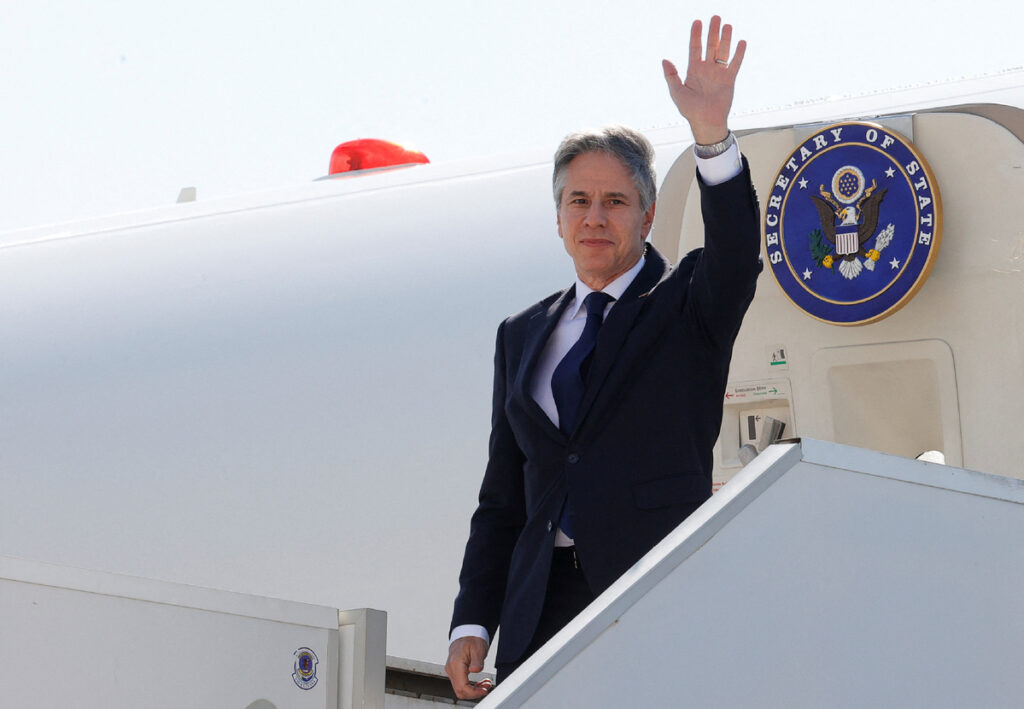Blinken’s Urgent China Visit: Mastering Crucial Diplomacy
8 min read
Contents
- 1 Importance of China-US diplomatic relations
- 2 Objectives of Antony Blinken’s visit
- 3 Schedule and key meetings during the visit
- 4 Major topics of discussion between Blinken and Chinese officials
- 5 Potential outcomes and implications of the visit
- 6 Analysis of the current state of China-US relations
- 7 Historical context of diplomatic visits between the two countries
One of the most impactful gestures of diplomacy is set to happen as the top US diplomat Antony Blinken is expected to visit China in a three-day trip. The visit, which is expected to take place amid a host of difficult topical issues, from trade disputes to human rights problems to regional security concerns, has been rapidly established as a protogel critical milestone in Sino-US relations . As the US State Secretary, Blinken, will address the necessity of open dialogue between the two sides, as well as cooperation, where it is possible, and counteraction, where it is necessary.
Therefore, the trip is extremely significant, as US-Chinese relations in the past decade have been marked by record levels of instability. This visit allows initiating high-level negotiations on several issues of mutual interest as part of the Biden administration’s efforts to bolster the American-Asian pivot . The visit to China is thus one of the most anticipated in terms of its potential repercussions in the field of international relations. At stake, however, is more than just a few days of talks and official dinners, but the future of cooperation and development of Sino-US relations in the upcoming years.

Importance of China-US diplomatic relations
Recent years have been marked by numerous challenges to China-US diplomatic relations. Trade disputes, intellectual property theft, and human rights concerns have created a rift and damaged mutual trust. The current visit presents an opportunity to address these grievances in a straightforward manner and find common ground on which the two countries can cooperate.
China-US relations also hold significant importance for the regional context, particularly the Asia-Pacific. As China continues to assert and expand its influence, the United States is attempting to balance power distribution in the region as well as enforce a rules-based order .
In this context, high-level discussions with China are designed to advance American interests and assist in promoting stability in the region. Objectives of Antony Blinken’s visit Antony Blinken’s visit to China has several objectives to accomplish. First and foremost, it is intended to facilitate open dialogue and enhance mutual understanding. In many cases, the leaders’ ability to talk face-to-face can generate more meaningful results that result from communication conducted from a distance. The second objective is exploring the possibilities of cooperation.
Despite the enmity, there are numerous fields, such as climate change, global health, and nuclear non-proliferation, in which the United States and China have mutual interests and can act in unison. The visit is expected to locate those fields and prepare a framework for future collaboration. The final objective is determining the matters of disagreement and discovering ways to approach remaining differences. Trade disputes, rights to intellectual property, and human rights issues have been the focus of disagreement in the past. Previous visits have provided an opportunity to advance those matters and achieve mutually beneficial solutions.
Objectives of Antony Blinken’s visit
The visit will take three days, and during this time, Antony Blinken with have a series of key meeting with Chinese officials. A planned schedule will ensure fruitful deliberations with meaningful results at the end of the visit. On the first day of the visit, Blinken is set to meet with his counterpart, Chinese Foreign Minister Wang Yi . This meeting will help to create an atmosphere for the visit and indicate the specific issues the two counties can discuss. Additionally, during this meeting, the two diplomats will discuss areas where the U.S. and China have trade disputes and human rights violation, including security issues in the region.
The second day of the visit will involve the meeting with other top Chinese officials, including Chinese Premier Li Keqiang and President Xi Jinping . While attending the meeting, he will be able to discuss matters of mutual interest that could not have been discussed with any other official. On the last day, he will meet Chinese Wang Y and participate in a press conference. The last day press conference will attract global attention because it is the time when issues discussed and views shared would get confirmation from the final speaker.

Schedule and key meetings during the visit
Antony Blinken will discuss various issues during the visit that are of mutual interest between the united states and China. The deliberations will be plain and well-laid-out and will address areas of cooperation as well as disagreement. One of the major topics to be discussed will be trade and the economy. Previously, the two countries had a trade war, where each country imposed a tariff on the other’s goods. The purpose of the discussion is to find a common stand and promote fair trading, which would benefit both countries.
Major topics of discussion between Blinken and Chinese officials
Furthermore, human rights issues will also be central to the conversation. The US has been particularly vocal about China’s poor treatment of the ethnic minorities in Xinjiang and its crackdown of protesters in Hong Kong calling for more democracy, freedom, and independence. It is expected that Blinken will express the US’s concerns about such violations and call on China to protect human rights and adhere to democratic principles and norms . Additionally, security matters, such as tensions in the South China Sea and China Strait, will be another focus point for the parties.
The US is concerned about China’s growing assertiveness, while China is claiming its sovereignty over its territories . Therefore, it will be critical for Blinken’s visit to help alleviate such fears and promote stability. Potential outcomes and implications of visit. Antony Blinken’s visit to China will have far-reaching implications for the two countries and the international community as a whole. It is difficult to forecast specific outcomes of the deliberations; however, several probable results can be discussed. First, the visit can facilitate increased mutual understanding between the US and China.
The direct engagement allows the parties to present and comprehend their worldviews and values, which can enhance mutual trust. As a result, the two states may further cooperate on global challenges. Second, the visit may result in a tangible agreement on particular cases, such as trade or human rights. Blinken’s arrival gives him the opportunity to present his worries over these matters and obtain agreed-upon decisions. Finally, a security-related outcome may involve a declaration to work toward mitigating the challenges in the region. The two countries can discuss measures to enhance peace and stability in the Asia-Pacific and avert potential standoff escalation.
Potential outcomes and implications of the visit
Thus, the visit has the potential to elevate the level of China-US relations. However, it is crucial to recognize that it is not possible to easily come to an agreement on complex matters. The actualization of the outcomes of the visit may also require additional negotiations and prolonged efforts. Current China-US relations can be analyzed through the use of the following information. The current relationship between China and the United States developed as a combination of competition and cooperation. As a result, the reasons for these combinations include the countries’ roles in the world and the extent of cooperation in economic matters. For example, one may note that the trade dispute between China and the United States is one such irritating matter.
Both countries have established tariffs on each other’s goods, which resulted in a decline of trade volumes . Intellectual property theft and forced technology transfer have been concerning matters for the United States . Human rights are another source of discontent. For example, the way China is treating Uighur Muslims in its province in Xinjiang and the suppression of pro-democracy activists in Hong Kong have led to severe criticism from the United States and other Western countries . At the same time, it is also true that China and the United States also recognize cooperation as an element that cannot be ignored.
For example, in the matters of nuclear non-proliferation, the 2019 political declaration to the issue of climate change, and the contribution of both to the Covid-19 research and prevention, cooperation between the Chinese and the U.S. States has been successful. However, if the matrix of competition and cooperation is to be constructed, the existing matrix is most likely to be the most comprehensive representation of the problem.

Analysis of the current state of China-US relations
Diplomatic visits between the two countries – historical context. Diplomatic visits between the United States and China have a long history and have been instrumental in defining and shaping the relationship between the two nations. One of the seminal visits was in 1972 when President Richard Nixon visited China, which marked a new era in the bilateral relations . Since then, a number of high-level visits by US presidents, secretaries of state, and other senior officials have taken place. These visits allowed leaders to engage in direct dialogues and develop personal relationships but have also obviously helped address some of the critical issues.
Historically, diplomatic visits were employed to “ease” tensions and establish a common ground: leaders were using the opportunity to discuss strategic issues, as well as economic cooperation and common concerns with regard to the regional security.
Despite some policy failures or minor setbacks, overall, the tool of diplomatic visits has been useful in managing the relations between the United States and China. Comparison to previous diplomatic visits by US officials . The comparison will help assess the potential impact of Blinken’s visit and its outcomes. While it is true that every visit may be different, there are some similarities and differences that can be drawn during this comparison.
The most obvious difference is an increased scrutiny of the Chinese actions and a more assertive stance of the United States to some of the issues, such as trade, human rights, and regional security. As a result, the tone and the nature of the dialogues are likely to be different. However, there are some continuities as well: the United States has certainly acknowledged the unique importance of maintaining open lines of communication with China. Thus, the nature of Blinken’s visit is likely to follow in the line with this tradition, and the visit is likely to be a message of engagement and readiness to directly address some of the issues.
Historical context of diplomatic visits between the two countries
Moreover, Blinken’s visit builds upon the previous visits, including the ones by former Secretary of State Mike Pompeo. Despite the differences in the means and ways to achieve the objectives, the visit is aligned with the Biden administration’s approach to China over the coming years. Conclusion. Future prospects: what the visit means for China-US relations . Antony Blinken’s visit to China is of great significance for China-US relations prospects. As the two countries’ top diplomat, his talks with Chinese officials can help address controversial issues, foster understanding and help identify cooperation areas.
While expectations related to the visit’s outcomes may vary, one should realize that improving the US-China relationship presupposes hard and consistent work and long-term vision. Solving big problems require time, and visits, including this one, should be regarded as small steps in the right direction. If you found this article informative and insightful, we invite you to explore our other pieces, including our article about the diverse world of coffee. Understanding global dynamics, whether in diplomatic relations or cultural exchanges, enriches our perspective and enhances our appreciation of the interconnectedness of our world.







